

See discussions, stats, and author profiles for this publication at: https://www.researchgate.net/publication/266630686 Classroom Presentation & Interactive System: Usability and Effectiveness Article · November 2011 DOI: 10.2316/P.2011.750-041 CITATIONS READS 0 929 1 author: Jinbao Zhang Beijing Normal University 14 PUBLICATIONS 35 CITATIONS SEE PROFILE Some of the authors of this publication are also working on these related projects: Computational Thinking Education Report View project All content following this page was uploaded by Jinbao Zhang on 13 February 2015. The user has requested enhancement of the downloaded file.
Proceedings of the IASTED International Conference Technology for Education and Learning (TEL 2011) October 24 - 25, 2011 Beijing, China CLASSROOM PRESENTATION & INTERACTIVE SYSTEM: USABILITY AND EFFECTIVENESS Jinbao Zhang Beijing Normal University No. 19 Xinjiekouwai Street, Haidian District, 100875 China zhangjb@bnu.edu.cn ABSTRACT PowerPoint presentations for classroom teaching, has million presentations every day and, depending on whose become routine in the university teaching activities. estimate you choose to accept, has between 250 and 400 However, there are many problems in the presentation of the million users around the globe(Alley & Neeley, 2005). application in classroom, for which researchers are Parker(2001) declared that there are great tracts of corporate developing a number of solutions. Compared to hardware America where to appear at a meeting without PowerPoint solution, PowerPoint-based classroom interactive software would be unwelcome and vaguely pretentious, like wearing has more advantages, and has strong promotional value. The no shoes. key factor for success of software products is really to Although many people believe that the PowerPoint provide users with a satisfactory service, enabling users to delivers contents with higher efficiency, dynamic effects adopt a strong will, and get a good use of effects. To this end, and better attractions. However, on the presentation of the the present research has chosen two certain classroom criticism has been going on. The criticism of PowerPoint interactive software (Microsoft Interactive Classroom and and the traditional slide design has surfaced in a variety of UW Classroom Presenter), through two pilot programs to specialized and general readership publications, from the field experience and comparative experiments, Harvard Business Review and Wired to the trade journals questionnaires and interviews the primary means of user Presentations and Successful Meetings and widely read willingness to adopt these products and the effect of periodicals such as The New Yorker, The New York Times, satisfaction. The results show that teachers and students The Chicago Tribune, and the Times of London. There is after the first exposure of such software have shown a high also a thriving discourse about PowerPoint on the Web, most adoption intention. They have higher satisfaction for the notably the weblogs www.edwardtufte.com and basic functions of the software and good reaction. In the end, www.sociablemedia.com. The range of these publications the paper also discusses the software problems and the lack and the vivid, emotional language used to discuss of research. PowerPoint reflect the key role that PowerPoint has played in a cultural shift in the way information is presented. KEY WORDS Stewart ( 2001 ) say WHY BAN POWERPOINT? --It's a Classroom interactive software, PowerPoint, interactive monopoly. --It's inescapable. classroom, classroom presenter, adoption intention, Yale professor Edward Tufte, a sociologist and a pplication ffect e respected expert in the analysis and visual display of quantitative information, is perhaps the most prominent 1. Introduction academic critic of PowerPoint (2003a–c and 2004). He has School was seen to education workplace. Classroom is the been a vocal proponent of a common theme in the criticism main place for transferring knowledge, and most important of PowerPoint: presentation slides that follow Microsoft learning support environment. The solution enhanced PowerPoint’s defaults tend toward reductionism because classroom is accessible concerned, particularly in the they oversimplify and fragment the subject matter. For oriental culture's country. All most everyone in China instance, in a critique of the investigative report about the confirms the statement of that instruction happened in Space Shuttle Columbia disaster, Tufte (2003b) argues that classroom is more important than in other place. So the traditional slides failed to characterize the risk that the government and parent wish to have best equipment in the ill-fated Columbia faced from its collision with debris at classroom. In 2009, Chinese government launches lift-off. These criticisms were echoed in a New York Times “Classroom to Classroom Net Project” which mainly article by Wald and Schwartz (2003). In his essay “The focuses on the usage of ICT in classroom. In the National Cognitive Style of PowerPoint,” Tufte (2003a) expands his Long-term Education Reform and Development Plan, ICT criticism of the Columbia slides and challenges the use of in classroom also has been considerably concerned. PowerPoint in all engineering presentations. One of Tufte’s Slides projected as overheads or by computers have major criticisms is that the default styles of PowerPoint limit become a conventional and dominant feature of engineering the amount of detail that can reasonably be presented. These presentations in academia, business, and professional default styles also encourage presenters to use bulleted lists societies. PowerPoint is used to make an estimated 20 to 30 that create many layers of hierarchy and ultimately obscure 98 DOI: 10.2316/P.2011.750-041
Recommend
More recommend